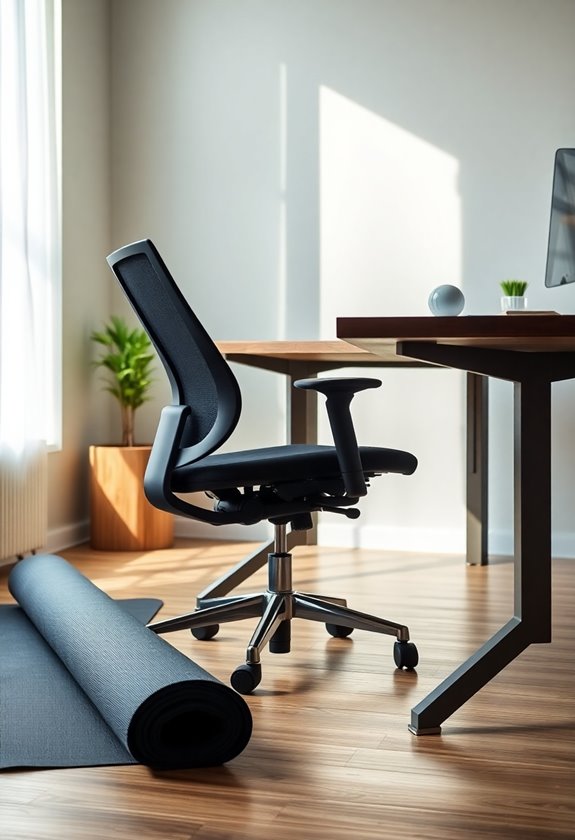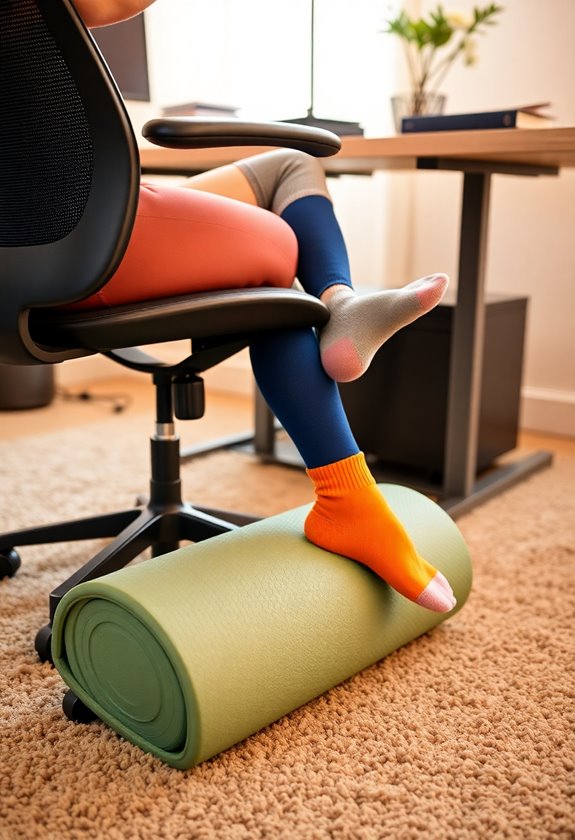You'll find quick stress relief right at your desk with these essential exercises. Start with shoulder rolls and neck stretches, moving in gentle circles while breathing deeply. Release wrist tension by flexing and spreading your fingers, then practice the "20-20-20 rule" to protect your eyes from screen fatigue. Decompress your lower back by bending forward between your knees, and don't forget to engage your core while seated. Combine these movements with deliberate breathing exercises – inhaling for 4 counts, holding for 2, then exhaling for 6. These foundational techniques open the door to an all-encompassing workplace wellness routine.
Highlights
- Perform shoulder rolls and neck stretches while seated to release upper body tension and improve posture.
- Practice deep breathing exercises with a 4-2-6 count pattern to quickly reduce stress and calm the mind.
- Release wrist and finger tension through gentle stretches and circular motions to combat typing fatigue.
- Decompress the lower back by hanging forward between knees for 30 seconds while taking deep breaths.
- Follow the 20-20-20 rule and eye-rolling exercises to reduce eye strain from computer screen exposure.
Shoulder Rolls and Neck Stretches

Office workers often carry tension in their upper body, making shoulder rolls and neck stretches essential desk exercises. You'll find relief by performing these movements several times throughout your workday, especially when you're feeling stiff or stressed.
Start with shoulder rolls by drawing large circles with your shoulders, moving them forward five times and then backward five times. For neck stretches, drop your right ear toward your right shoulder while keeping your left shoulder pressed down, holding for 15-20 seconds before switching sides. You can also gently turn your head from side to side, maintaining each position for several breaths to release built-up tension. If you're experiencing persistent tightness, try combining these movements with deep breathing to enhance their relaxation benefits.
Wrist and Finger Release

Just as the shoulders and neck need attention, your wrists and fingers deserve care during long workdays at the computer. Extended typing and mouse use can create tension in your forearms, wrists, and finger joints, potentially leading to discomfort or repetitive strain injuries.
Using an ergonomic computer mouse can provide additional comfort and support while performing these exercises.
Try these effective wrist and finger releases:
- Extend your arms forward and flex your wrists up and down for 10 counts, maintaining gentle pressure at each position
- Spread your fingers wide, hold for 5 seconds, then make tight fists for another 5 seconds
- Circle your wrists clockwise 5 times, then counterclockwise 5 times
- Gently pull each finger back toward your wrist until you feel a mild stretch
Perform these exercises every two hours to maintain flexibility and reduce the risk of developing carpal tunnel syndrome or other repetitive stress conditions.
Deep Breathing Reset

While physical movement helps release tension, deep breathing is your most powerful tool for instant stress relief at your desk. When you're feeling overwhelmed, try this simple yet effective breathing reset:
- Sit up straight and place both feet firmly on the floor, letting your shoulders drop away from your ears.
- Inhale slowly through your nose for a count of four, feeling your belly expand rather than your chest.
- Hold your breath gently for a count of two, maintaining relaxed shoulders and a soft jaw.
- Exhale through your mouth for a count of six, releasing any tension you're holding in your body.
Repeat this cycle three to five times whenever you're feeling stressed, and you'll notice your heart rate slow down as your mind becomes clearer and more focused.
Lower Back Decompression

After calming your mind with deep breathing, your body deserves equal attention. Your lower back often bears the burden of prolonged sitting, but you can decompress those compressed vertebrae right at your desk.
Consider using an anti-fatigue mat while performing these exercises to reduce pressure on your joints and enhance comfort.
- Scoot your chair back from your desk and plant your feet firmly on the floor, hip-width apart
- Slowly bend forward, letting your upper body hang between your knees while keeping your neck relaxed
- Allow your arms to dangle toward the floor, releasing tension through your spine and shoulder blades
- Hold this position for 30 seconds while taking deep, steady breaths through your nose
- Gradually roll back up to seated position, one vertebra at a time, ending with your head
You'll feel an immediate release of pressure in your lower back as circulation improves and muscles lengthen.
Eye Strain Relief Techniques

Looking up at computer screens throughout the day puts immense strain on your eyes, leading to fatigue, headaches, and blurred vision. You can protect your vision and reduce eye strain by incorporating regular eye exercises into your daily routine, which will help maintain your visual health and prevent long-term damage from prolonged screen exposure. Installing anti-glare screen protectors can significantly reduce eye fatigue by minimizing reflections and harsh glare from your displays.
- Practice the "20-20-20 rule" by looking at something 20 feet away for 20 seconds every 20 minutes, allowing your eye muscles to relax and readjust
- Roll your eyes in clockwise circles for 10 seconds, then counterclockwise for another 10 seconds, helping to strengthen eye muscles and increase flexibility
- Frequently blink deliberately and slowly for 30 seconds to naturally lubricate your eyes and prevent the dryness that often occurs during extended screen time
Seated Core Engagement

Strengthening your core doesn't require leaving your desk or disrupting your workflow. You'll find that simple, controlled movements while seated can effectively engage your abdominal muscles and improve your posture throughout the day.
Try these seated core exercises during your workday:
- Sit tall with both feet flat on the floor, then slowly draw your navel toward your spine while maintaining normal breathing
- Perform gentle twists by placing your hands on your armrests and rotating your torso from side to side
- Lift your feet slightly off the ground while keeping your knees bent, holding this position for 10-15 seconds
- Practice "pulse" movements by tightening your abs for 2-3 seconds, then releasing, repeating this 10 times
Remember to maintain proper form and don't strain yourself while performing these movements.
Ankle and Leg Circulation

Prolonged desk sitting can cause poor blood flow in your legs and feet, leading to discomfort and potential health issues. You'll want to perform simple circulation exercises every hour to keep blood flowing properly through your lower extremities, which can help prevent swelling and reduce the risk of blood clots.
- Point and flex your feet alternately under your desk, holding each position for five seconds while engaging your calf muscles throughout the movement
- Rotate both ankles in circular motions, first clockwise then counterclockwise, completing 10 circles in each direction
- Lift your heels while keeping your toes on the ground, then switch to lifting your toes while keeping your heels down, repeating this movement 15 times
These exercises don't require standing up, so you can perform them discreetly while continuing your work tasks.
Frequently Asked Questions
How Long Should I Wait After Eating Before Doing Desk Exercises?
You should wait 30-45 minutes after a large meal before doing desk exercises to avoid discomfort and potential digestive issues. For lighter snacks or small meals, you can start gentle movements after 15-20 minutes. If you've eaten a particularly heavy meal, it's best to extend your waiting time to an hour, ensuring your body has begun the initial stages of digestion before engaging in any physical activity.
Can Desk Exercises Help With Weight Loss During Work Hours?
Just as small drops of water can fill a bucket over time, regular desk exercises can contribute to your weight loss goals during work hours. You'll burn extra calories through movements like seated leg raises, desk pushups, and chair squats while maintaining productivity. Though you won't burn as many calories as traditional workouts, these exercises can help you stay active, boost metabolism, and complement your overall weight management efforts throughout the workday.
What Should I Wear to Perform Desk Exercises Comfortably?
You'll want to wear business-appropriate clothes that allow comfortable movement, such as stretchy slacks or A-line skirts with enough give. Choose breathable, loose-fitting tops made from materials like cotton or moisture-wicking fabrics that won't restrict your arms or torso. If you're wearing dress shoes, keep a pair of supportive flats under your desk for exercises that require standing or ankle movements.
Are Desk Exercises Safe for Pregnant Women in the Workplace?
While desk exercises can be beneficial during pregnancy, you'll need to consult your healthcare provider before starting any workplace exercise routine. Most gentle stretches and posture-improving movements are safe, but you should avoid any exercises that strain your abdomen or require balance. Listen to your body's signals, and don't push yourself if something feels uncomfortable. You can modify common desk exercises to accommodate your changing body and energy levels.
How Often Should I Take Breaks to Perform These Exercises?
You should take a break every 30-60 minutes to perform desk exercises, which helps prevent muscle stiffness and maintain good circulation. While longer breaks are beneficial, even quick 1-2 minute stretch sessions throughout your workday can make a significant difference in reducing tension and improving your overall comfort. If you're doing computer work, follow the 20-20-20 rule: every 20 minutes, look at something 20 feet away for 20 seconds.




